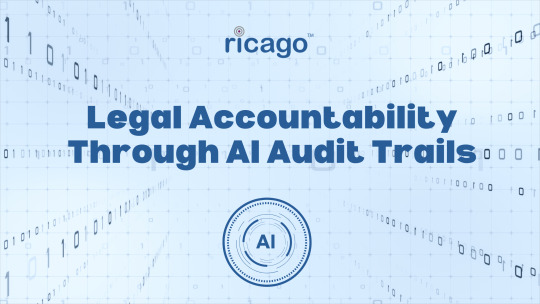Don't wanna be here? Send us removal request.
Text
Legal Accountability Through AI Audit Trails

In 2025, a major financial institution faced a regulatory investigation after an AI system made automated trading decisions that led to market disruption and significant losses. The firm is unable to provide sufficient audit trails to explain the logic behind the decisions, highlighting a point robust AI audit trails are now a legal and operational necessity. As AI increasingly impacts regulated industries such as finance and healthcare, the need for transparency and legal accountability has become crucial for compliance. The emergence of AI audit trails is now essential for managing risk, oversight, and trust within organizations.
The Importance of Audit Trails Matter in AI Systems
Traditionally, audit trails are essential in sectors such as cybersecurity and finance as maintaining secure, time-stamped records of system activity is crucial in AI, especially under evolving regulatory frameworks, for creating audit trails.
Transparency: Clarifying AI-driven decisions for stakeholders.
Traceability: Documenting data flow, and decision making.
Accountability: Identifying responsibility for errors and violations
Compliance: Supporting audits and regulatory assessments.
Regulatory Factors Behind the EU AI Act
These align with industry guidance and regulatory proposals expected to become binding in the near future.
Documentation with capabilities (Annex IV).
Monitorable risk management procedures (Article 17).
Post-market obligations using accessible audit logs (Article 61).
In the U.S, regulators like the SEC and FTC are increasing scrutiny of AI use in making decisions, expected requirements include:
Tracking data lineage sources to model inputs.
Documentation of data version histories
Explainable justification for AI-based decisions
This aligns with industry guidelines and upcoming mandatory proposals.
Components of AI Audit Trail
A comprehensive AI audit trail should capture the following elements:
User interactions: Who accessed the AI system, when, and why.
Model usage: Which models were invoked, with what inputs and resulting outputs.
Data flow: How data was ingested, processed, transformed, and utilized.
Model evolution: Retraining events, tuning, and version control histories.
Policy enforcement: Logging of security events, exceptions, or compliance breaches.
What are the Operational and Legal Benefits
AI audit trails provide significant benefits more than just a compliance tool, including:
Alignment with regulations, including with EU AI Act, GDPR, and U.S. financial laws.
Risk mitigation and prevention of misusing the model.
Faster response and effective resolution of failures.
Increased trust with regulators and customer transparency.
Legal Accountability and Third Party Auditing
There is consensus on the need for independent oversight of AI systems. Current proposals include:
AI incident reporting system to prioritize audits.
Independent boards to certify AI auditors.
Legal protections for certified auditors to promote transparency.
Conclusion In this new era of transparent and accountable AI, Ricago empowers organizations to meet regulatory expectations. With built-in audit trail capabilities, customizable compliance workflows, and deep integration with governance frameworks, Ricago ensures your AI systems are both explainable and fully traceable. Its intelligent dashboards, automated logging, and real-time compliance monitoring make it the ideal solution for regulated entities seeking operational resilience and ethical AI. Choose Ricago not just to comply, but to lead with trust.
1 note
·
View note
Text
NSDL Receives Warning from SEBI, Impacting Market Governance

The Securities and Exchange Board of India (SEBI) has issued a warning and show-cause notice to the National Securities Depository Limited (NSDL), due to serious concerns about compliance failure and cybersecurity weakness. The action follows an inspection by SEBI of NSDL for the financial year 2023–24, during which non-compliance with key regulatory standards was identified.
Emphasizing Compliance and Cybersecurity
This development comes shortly after NSDL settled another compliance case by paying ₹3.12 crore under the Depositories and Participants Regulations, 2018. That case involved a delay in grievance redress and failure to meet the code-of-conduct requirements.
Additionally, SEBI has raised concerns regarding NSDL’s response to a cyberattack that occurred in October 2023. The regulator questioned the timeliness and adequacy of incident reporting and highlighted that the growing expectations are rapidly rising amid growing threats to financial stability. Regulatory technology tools enable market infrastructure institutions to reduce risk, respond swiftly to threats, and adapt to regulatory changes.
By automating compliance management will change how financial institutions tackle regulatory and cybersecurity challenges.
Understanding Systemic Risk and the Impact of Market Stability
NSDL plays a vital role in India’s capital markets by safeguarding assets and settling millions of trades. Any weaknesses in its compliance or cybersecurity could have significant repercussions throughout the financial ecosystem, threatening both investor confidence and operational continuity.
SEBI’s warnings indicate a broader regulatory shift towards zero tolerance for gaps in governance among market infrastructure institutions (MIIs).
Why Modernization is Important?
The situation highlights the important necessity for institutions like NSDL to modernize:
Real-time compliance monitoring
Advanced cyber threat detection and response
Overhauling legacy IT systems
By utilizing regulatory technology tools, market infrastructure institutions can reduce their risk exposure, ensure faster response to threats, and meet evolving regulatory expectations. Compliance Management automation and AI will redefine how financial institutions tackle regulatory and cybersecurity challenges
Conclusion
SEBI’s action against NSDL highlights the urgent need for robust governance, real-time oversight, and cyber resilience are now essential pillars of market integrity. Institutions that don’t adapt may face penalties, but a loss of trust. As we move further into 2025, Compliance Management automation and AI will redefine how financial institutions tackle regulatory and cybersecurity challenges.
Automation reduces errors and accelerates reporting, while AI-powered analytics provide predictive insights to identify risks before they escalate.
Companies like Ricago lead this transformation, providing solutions for real-time compliance monitoring and enhanced cyber resilience. Embracing these technologies is essential for market stability and investor trust.
1 note
·
View note